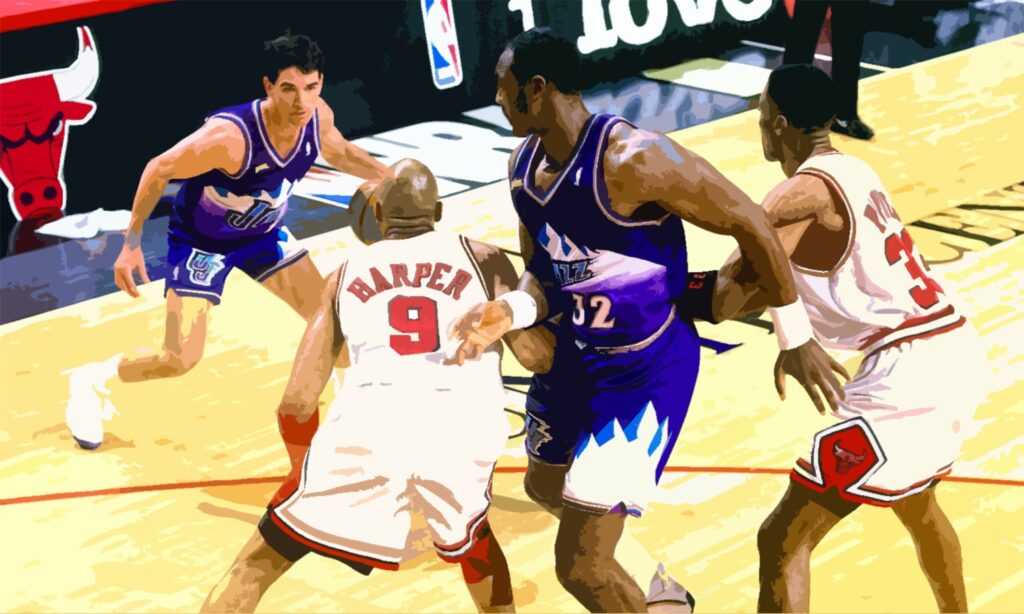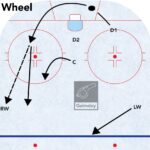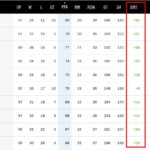In basketball, there are different strategies employed by the coaching to get the offense rolling.
Every sequence is typically different, otherwise teams would be too predictable and easy to defend against.
You cannot be a one-trick pony, relying on a certain player or play to score each time.
When you look back at NBA history, the best players to win championships were always surrounded by great teammates and solid role players.
Those players and their offensive talent were key to securing the wins.
What type of offensive strategies did these players employ?
We’re talking about motion offense, fast breaks, post-ups, give and gos, isolations, pick and rolls - and I can go on and on.
The pick and roll was highly popularized in the 90s, especially by John Stockton and Karl Malone of the Utah Jazz.
But let’s give credit to the duos of Larry Bird and Kevin McHale (Boston Celtics) and Magic Johnson and Kareem Abdul-Jabbar (Los Angeles Lakers).
They employed the pick and rolls just as effectively to the detriment of their opponents.
That said, let’s explain the pick and roll in more detail.
What is a Pick and Roll in Basketball?
A pick and roll is an offensive play where one player sets a screen for their teammate handling the ball. The handler uses the screen as a shield, allowing him to drive the basket, shoot or pass the ball off. The player who set the screen “rolls” to the basket to draw the defender away from the ball handler.
The reason the pick and roll is so effective is that it staggers the defensive coverage into a size mismatch or even to confusion for who’s covering who.
Key elements of a successful Pick and Roll
The most important element of the pick and roll is communication between the ball handler and screener.
Timing and positioning is most important by the screener as it allows the ball handler to take advantage of the open space.
Once the pick is achieved, the next step is to see how the defense will react to it.
The ball handler can choose to drive to the basket, take a mid-range shot, or pass to the rolling screener or an open teammate.
After setting the screen, the screener should quickly and decisively roll toward the basket. This movement draws defenders and creates scoring opportunities near the rim.
Furthermore, a successful pick and roll requires the ability to adapt to changing defensive strategies.
Players must react to how defenders switch, hedge, or trap the pick and adjust their actions accordingly.
How to defend against a Pick and Roll?
There are several ways to defend against the Pick and Roll depending on the situation.
The two most common defensive tactics are once the pick is it set are Hedging or Switching.
A more aggressive tactic would be Trapping the ball handler.
And lastly, if possible, the original defender can Fight through the Screen.
I will explain each of these scenarios in further detail below.
Hedging
One defender can hedge or show aggressively on the ball handler after the screen is set, buying time for the original defender to recover.
The hedging defender then quickly retreats to their original assignment.
Switching
Defenders can switch assignments, trading who guards the ball handler and the screener. This helps deny open driving lanes and passing lanes, disrupting the offensive flow.
Switching is most ideal if the mismatch in size and weight are minimal between the swapped parties.
If the ball handler has a size advantage on the switch, they may opt to shoot the ball or drive the net with ease.
Meanwhile, if the screen player has the advantage on the switch, the ball handler may pass him the ball for an easy close-up bucket on the “roll”.
Trapping
Employing a trap involves two defenders aggressively double-teaming the ball handler to force a quick decision.
This can lead to rushed passes or turnovers, disrupting the pick and roll play.
Fighting through Screens
Defenders can work to navigate around or through screens to maintain coverage on the ball handler. This prevents easy passing options and shots.
What are the different variations of the Pick and Roll?
The last thing the offensive team wants is to be predictable on the court.
Once the pick is set, the steps after should not be telegraphed by the defensive team.
You want to make sure that you have different options to throw them off during the sequence.
Here’s a list of options players can execute once the pick and roll is in motion.
Variations of the Pick and Roll
| Pick and Roll Variations | Description | |
|---|---|---|
| 1 | Standard Pick and Roll | The ball handler uses a screen to create separation and drive to the basket or take a jump shot. The screener rolls to the basket for a potential pass or offensive rebound. |
| 2 | Pick and Pop | Instead of rolling to the basket, the screener "pops" out to the perimeter for an open jump shot. This variation takes advantage of the screener's shooting ability. |
| 3 | Double Pick and Roll | Two players set screens consecutively for the ball handler. This can create confusion in the defense and provide multiple options for the ball handler. |
| 4 | Slip Screen | The screener acts as if they're setting a pick but slips to the basket before making full contact with the defender. This catches the defense off-guard and can lead to an open scoring opportunity. |
| 5 | Short Roll | The screener rolls to a spot closer to the free-throw line instead of all the way to the basket. This can create a mid-range scoring opportunity for the rolling player or allow them to make a quick pass. |
| 6 | Roll and Replace | After setting the screen, the screener quickly replaces the ball handler's original position on the court, offering a passing option or a secondary pick. |
| 7 | Pick and Roll w/ Delay | The ball handler waits a moment after the screen is set before using it. This can confuse defenders and create additional separation. |
| 8 | Point Forward Pick and Roll | A forward or wing player initiates the pick and roll as the primary ball handler, utilizing their size and versatility to create mismatches. |
| 9 | Pick and Roll off a Handoff | Instead of a traditional screen, the ball handler receives a handoff from the screener and then attacks the defense, using the handoff as a pseudo-pick. |
| 10 | Pick and Roll into Isolation | The offense starts with a pick and roll but if the defense collapses or switches, the ball handler can isolate against a mismatched defender. |
| 11 | Pick and Roll with Cross-Screen | A teammate sets a cross-screen for the screener, who then rolls to the basket. This can lead to easy scoring opportunities if the defense is caught off-guard. |
| 12 | Pick and Roll with Back Screen | A back screen is set on the ball handler's defender after the pick, allowing the ball handler to cut to the basket for a lob or quick pass. |
Final Thoughts
When they say the game of basketball is non-contact sport, I tend to disagree.
While it is true that players cannot blatantly hit or knock down their opponents like in football and hockey, there is plenty of physicality going on.
And I’m talking about the legal elements of the game.
The perfect example is the pick and roll play.
The reason it is so effective is because defender is unaware of the screen set in place for him.
Running into the blocker can feel like running into a brick wall if you don’t anticipate the play.
That said, it is common strategy that teams run normally during a game.
But the pick is only a part of the sequence.
To make it effective, the idea is to collapse the defense, score the basket or, at least, draw the foul.
You want to keep your opponents on their heels and mentally wear them down.
To win the game you must be always thinking OFFENSE, OFFENSE, OFFENSE!
And nothing screams more offensive strategy than the pick and roll!






